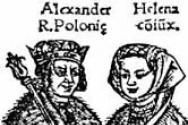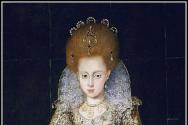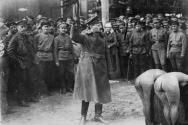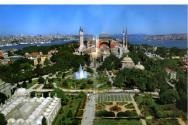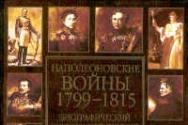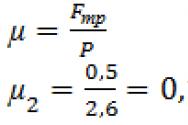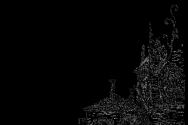Presentation on the topic of the formation of the ancient Russian state. History of Russia Formation of the Old Russian state among the Eastern Slavs Teacher Zhilonene S.V. Oleg's campaign against Constantinople
The Old Russian state - Kievan Rus Purpose: To trace the stages of the formation of the Old Russian state, to identify the features of development at each stage. Problem: Is the state of the Slavs the result of a natural stage in the development of Rus', or was it introduced from the outside (by the Varangians)? Practical significance: To form an idea of the role of the state in the life of society - regulation of social relations, protection of borders, maintenance of order.
The main stages of the formation of ancient Russian statehood Initial stage Mid-IX - end of 10th century. Ruling princes Oleg () Igor () Olga () Svyatoslav () Heyday End of the 10th - first half of the 11th century. Ruling princes Vladimir () Yaroslav () Decline, collapse Second half of the 11th - mid-12th centuries. Ruling princes Vladimir Monomakh ()


The main theories of the formation of the Old Russian state Norman (Bayer, Schletser, Miller) The founders of the Old Russian state are the Normans, whom the Slavs called to their lands to rule them. The name "Rus" is of Scandinavian origin. The Slavs are not capable of creating their own statehood. Anti-Norman (M. Lomonosov) Among the Eastern Slavs there was a process of decomposition of the clan system and the development of feudalism, the formation of statehood before the arrival of the Varangians. The influence of the Scandinavians on the formation of the state is insignificant. The name “Rus” is of Slavic origin.


Adoption of Christianity Reasons: The need to unite tribes. Justification of social inequality. Increasing international authority. Introduction to Byzantine culture. Significance The rapprochement of Slavic and Finnish tribes. Expansion of international relations. Development of writing, painting, architecture. A blow has been struck to tribal customs (blood feud).

Byzantine influence on Rus' after the introduction of Christianity Power The power of the metropolitan extended to all of Rus'. Support of the grand ducal power. Land ownership Churches and monasteries received land ownership. Byzantine customs and laws were established on church lands. Enlightenment The spread of writing, the creation of schools, the emergence of scribes - learned people. Laws and courts The clergy judged the people under them based on the laws of the Greek church.

Rurik Dynasty 962-Rurik's Calling Campaign to Byzantium Oleg Kyiv founded: Kiy, Shchek, Khoriv. 882-Capture of Kyiv (Askold, Dir). Igor War with Byzantium. Collecting tribute during polyudye. 945-Murder of Igor by the Drevlyans. Peace with the Pechenegs 943-Campaign south to the Black Sea and the North Caucasus. Olga conquered the Drevlyans (avenged the death of her husband). 955-Trip to Tsar-Grad. She organized graveyards, introduced lessons (a certain amount of tribute), and administrative units.

I. Glazunov. Prophetic Oleg Died in 912 Prince Igor Died in 944/945 V. Vasnetsov. Varangians (fragment) Calling of the Varangians. According to the Laurentian list of the Tale of Bygone Years, Rus', Chud, Slovenes and Krivichi sent an embassy overseas: “Our land is great and abundant, but there is no order in it. Come reign and rule over us."

Svyatoslav Conquered the Vyatichi, 967-Campaign on the Danube, 971-War with Byzantium Campaign on the Khazars, on the Dnieper. Founded settlements in Tmutarakan Vladimir “Red Sun” Pagan reform Baptism of Rus'. Construction of temples and churches, spreading literacy. Svyatopolk “The Accursed” War with Yaroslav for the great reign. Murder of brothers Boris and Gleb (canonized).

B. Olshansky Tradition about Svyatoslav Saint Vladimir Died in 1015 The chronicle noted that the prince “fought a lot... did not carry carts or boilers with him, did not cook meat... He did not have a tent, but slept with a saddle in his head...” Svyatoslav was a pagan, he owns the phrase: “We will not disgrace the Russian land, but we will lie down with bones, for the dead have no shame!” Vladimir Svyatoslavich is glorified by the Russian people in epics and nicknamed Vladimir the Red Sun. In 988 the Baptism of Rus' took place. After accepting Christianity, He built many churches (Church of the Virgin Mary in Kyiv, etc.). Under Vladimir the Saint, the minting of gold and silver coins began.

Yaroslav "The Wise" Victory over the Pechenegs. Divided Rus' into fiefs. Conclusion of dynastic marriages. Code of laws "Russian Truth". Founded the Hagia Sophia. Izyaslav Uprising in Kyiv. The end of the 11th century, the beginning of Russian chronicles. Vsevolod Svyatopolk Second half of the 11th century - Founded the Kiev-Pechersk Monastery Nestor “The Tale of Bygone Years” Victory over the Polovtsians Congress of Princes in Lyubech.

LESSON GOALS: educational: analyze the process of formation of the Old Russian state, noting its natural character; creation of a holistic idea of social relations in Rus' in the 22nd century. and their development; acquaintance with “Russian Truth”. developing: developing skills in working with historical documents; developing the ability to extract historical information from them, analyze, generalize, draw conclusions and apply the acquired knowledge to solve cognitive problems. The ability to see a problem and outline ways to solve it. educational: developing interest in Russian history and historical research through direct contact with historical documents. 2




Tribal unions of the Eastern Slavs in the 9th century. Krivichi Upper reaches of the Volga, Dnieper, Western Dvina rivers Vyatichi Oka River Slovenes Ilmenskie Around Lake Ilmen and along the Volkhov River Radimichi Sozh River Drevlyane Pripyat River Dregovichi Between the Pripyat and Berezina rivers Glades Along the western bank of the Dnieper River Ulichi and Tivertsy South-west of the East European Plain Northerners Along the rivers Desna, Seim, Sula, Seversky Donets Croats, Duleby Danube and Carpathian region Polotsk Basin of the Western Dvina River Volynians, Buzhany Carpathian region 7

Kievan Rus during the “gathering of lands” period - 80s of the 9th century - end of the 10th century. According to the Tale of Bygone Years (beginning XII), the creation of a powerful state on the territory of Eastern Europe began from the north. The Northern Tribal Union with its center in Novgorod was formed here. The southern tribal union was located in the Middle Dnieper region, in the area of the Ros River with its center in Kiev. The core of the ancient Russian state was formed here. Payment of tribute to the Varangians 8

Prerequisites for the emergence of the state among the Slavs Political: strengthening the role of the military nobility (prince, squad) Economic: the emergence of property inequality Social: transition to a neighboring community; Foreign policy: constant military pressure from neighbors (nomads, Varangians) 9

Rurik () The chronicle reports that in 862 the Novgorodians expelled the Varangians overseas, but there was no peace among the multilingual tribes, so in 862 representatives of the tribes called on a foreign prince to restore order among them.. In 862, Rurik’s troops occupied lands along the shores of Ladoga, and in 864 he annexed Beloozero and Izborsk. Rurik put his people to rule in other cities. Prince Rurik became the head of a dynasty that ruled the Russian lands for more than 700 years. 10

11

Oleg () - After the death of Rurik in 879, Oleg became the leader of the Varangian troops. -. The prince’s main task was to master the most important route “from the Varangians to the Greeks.” - In 882 Prince Oleg made a campaign to the south and killed the Kyiv princes Askold and Dir. - Oleg declared Kyiv his capital and took the title of “Grand Duke”. - As a result of the unification of the north and south of the East Slavic lands, the Old Russian state was formed - Kievan Rus. - (Organization of power and management in the 9th-10th centuries) (Organization of power and management in the 9th-10th centuries) 12


Is it true that power at the stage of formation of the Old Russian state was based on the use of force? Prove it or disprove it. Appendix 1. Expansion of the territory of the Old Russian state.ppt Appendix 1. Expansion of the territory of the Old Russian state.ppt 14

Polyudye The most important source of income for the prince and his squad was the tribute (polyudye) paid by the conquered tribes. Polyudye performed the role not only of collecting tribute, but also carried out the power functions of the prince: he communicated, “reminded” of his leadership, and judged. It was Polyudye that connected together lands that were often far apart from each other. 15


Igor was immoderate in his demands on the defeated tribes. The Drevlyans said: “If a wolf gets into the habit of attacking the sheep, he will carry out the whole flock. We will kill him.” And they killed Igor and his squad that was with him. 17

The next year, the princess gathered a large army and set out on a campaign against the Drevlyans. The Drevlyans were defeated, Iskorosten was burned, some of its inhabitants were enslaved, the rest were subject to heavy tribute, a third of which went to Vyshgorod, which belonged to Olga, and two-thirds to Kyiv. Is it possible to say that he was a great ruler when he destroyed one of the East Slavic tribes solely for the purpose of avenging the death of his husband? Princess Olga burns Iskorosten 18

Olga's Reform Having completed her revenge, Olga began to organize the Russian land. Olga established certain amounts of tribute - “lessons”, and set up her camps and graveyards throughout the land. The camp, apparently, was the name of the place where the princes stopped when traveling to Polyudye. By graveyards we should rather understand the fortified courtyards of the princely clerks - tiuns, where the surrounding population brought tribute. Gradually they turned into strongholds of princely power in remote areas. The “polyudya” system is replaced by a “cart” - delivering tribute to the churchyard. 19



Vladimir () In the 9th – 10th centuries. The Kyiv princes gradually subjugated the East Slavic unions of tribal principalities. With the liquidation of the autonomy of the Slavic unions of tribal principalities, the formation of the state of Kievan Rus is completed. The adoption of Christianity as the state religion by Prince Vladimir (988) became an outstanding act that politically and ideologically consolidated the formation of a single Old Russian state. (organization of power and administration in the 11th-13th centuries). (organization of power and administration in the 11th-13th centuries) 22

CATHEDRAL OF PRINCE VLADIMIR Built in the 90s of the 20th century. Built in the 90s of the 20th century. Architect - A. Oreshnikov. Architect - A. Oreshnikov - first service, city - first service. July 2001 - Alexy II visited July 2001 - Alexy II visited 23


MAIN DIRECTIONS OF INTERNAL AND FOREIGN POLICY OF THE FIRST RUSSIAN PRINCE Creation of a single state Unification of the East Slavic lands Religious reform Strengthening princely power Strengthening the management system Organized taxation system Strengthening diplomatic ties with Byzantium and European states Strengthening the foreign policy power of Rus' 25

Yaroslav the Wise () After the expulsion of Svyatopolk and with the death of Mstislav, Prince Yaroslav became the sole ruler of the Russian land. Distinguished by his great intelligence, he skillfully ruled Russia: He cared a lot about the needs of the country, built cities (Yaroslav and Yuryev), erected churches (St. Sophia in Kyiv and Novgorod), established schools and promoted writing in Rus'. He is also responsible for publishing the first set of legal customs, known as “Russian Truth.” 26


Russian Truth “Russian Truth” is a collection of princely laws. More than a hundred lists of Russkaya Pravda have survived to this day. All lists fall into three main editions: Short, Long and Abridged. The oldest edition, prepared no later than 1054, is the “Brief Truth”, which consists of “The Court of Yaroslav Vladimirovich” (in the literature usually called “The Truth of Yaroslav”) (articles 1-18), “The Truth of the Yaroslavichs”, i.e. sons of Yaroslav - Izyaslav, Svyatoslav and Vsevolod (articles 19-41), “Pokon Virny” (article 42), “Lesson of the Bridge Workers” (article 43). 28









Complete the task: answer the question. ? A person who has become completely dependent on his master is a slave. ? A person who has entered into an agreement to perform certain duties in favor of a master. ? A ruined community member who went into debt bondage for a loan, the interest on which he earned in the field from the person who lent him money. ? A person who was initially free, but gradually became dependent on the feudal lord. in favor of the prince. 38
Features of the early state Every community that is ripe for the creation of statehood goes through the stage of the early state. Signs of the early state Ancestral remnants The hereditary power of the prince The veche is preserved - a meeting of free community members A permanent squad, personally devoted to the prince People's militia if necessary A special court of the prince Traditional law (blood feud and God's court) The emergence of categories of dependent population (slaves, purchases, ryadovichi) The dependence of the community members is limited to the collection of tribute 41
Conclusions: The head of the state was a prince, largely dependent on the squad; The management apparatus is not developed. Dominance of state property; The classes of feudal society did not develop: the class of feudal lords and dependent peasants; The peasants were not enslaved; The power of the prince depends on the community, the people's militia. The established Old Russian state can be characterized as an early feudal monarchy. « 42
: : Used literature Russia in the works of Russian historians / N.M. Karamzin. History of the Russian State / History of Russia (6th grade) - lessons on the history of Russia in the 7th-15th centuries. using a computer. illustrations, maps, diagrams /lesson-history.narod.ru/.lesson-history.narod.ru Materials of Russian history (works by V.N. Tatishchev, N.K. Karamzin, N.I. Kostomarov, lectures by S.M. Solovyov, V.O. Klyuchevsky, S.F. Platonov, Metropolitan Macarius) /magister.msk.ru/.magister.msk.ru The first Russian princes. /portfolio.1september.ruportfolio.1september.ru



In the most common meaning of the word - a fortified dwelling of a feudal lord in medieval Europe. Ritter, originally - horseman) is a medieval noble honorary title in Europe. The finest example of Western European (Italian) fortification construction is the Moscow Kremlin. Knight (German: Black Knight. All about castles. Early European castles were built mainly from wood.
“The end of Horde rule” - Lesson objectives. Complete the tasks for paragraph 20 in your workbook. Is it a miracle? What choice did Ivan have? Study paragraph 20 to the end, retell paragraph 2, answer questions 3,4,5. A prayer service was held in the churches. Casimir did not dare to oppose the Horde. Standing on the Ugra. A reason for a clash with the Horde. It was restless in Novgorod. A six-month stand on the Ugra River put an end to the Horde yoke. Akhmat fled.
“Medieval India” - Products made of ivory and valuable wood species. From the 7th-8th centuries. Hindu temples are built in the form of huge towers. Indian numbers. Artistic crafts. Minaret. The walls of the temples were completely covered with reliefs, statues and elaborate carvings. Buddha statue in lotus. Statue of the dancing god Shiva. Architecture. Buddhist temples in Ajanta. Scientific discoveries. Legends and historical events are reflected). Mausoleum of the Taj Mahal.
“Culture of the Caliphate” - Pre-Islamic poets sang of the brave warrior, generous and true to his word. Repetition of what has been covered. Arabic script. Miniature from Shahnameh. One of the most famous poets was Ferdowsi (934-1020). Sometimes a dome was erected over the mosque, but more often the roof was flat. Ferdowsi. The whole world knows the Alhambra - the emir's palace in the Spanish city of Granada. Al-Biruni. Muslim primary schools were private. 2. Science. Miniature from an Arabic manuscript.
“Kiev culture” - Church of St. Sophia, Kyiv, XI century. The influence of the cultural traditions of Byzantium. Using the traditions of Byzantine art. Written. Cross-domed church, image of saints. Bow and arrows. Spread of Christianity. The Tale of Bygone Years. Narrative. CULTURE - сultura: cultivation, care; agriculture; education, upbringing; worship, veneration." Culture of Kievan Rus. 1. Match.
“Heroes of Ancient Greece” - What feat did Theseus accomplish? What is the difference between myth and legend? Let's try to think about the myth about the great singer. Theseus and the Minotaur. Who and how helped Perseus cope with the jellyfish? Guessing the meaning of mythological images is very interesting and difficult. Homework check Written survey. Heroes of Ancient Greece. Tell us how Perseus was born. What does the Gorgon Medusa look like? Snake bite... Orpheus. What is a myth?
1 slide

2 slide
Purpose of the lesson: To consolidate the concept of the state. Consider the theories of the emergence of the state among the Slavs. Find out the reasons and prerequisites for the emergence of the state. Think: do you agree with the Norman theory of the origin of the state? Concepts: polyudye, prince, boyars, governor.

3 slide
The concept of a state (try to give the concept using your knowledge) A state is a Territory that has borders Border protection Regulator of relations between people A unified management system Unified laws (customs) functions

4 slide

5 slide
The city is a center of trade, crafts, a tribal center, a fortress (stockade, detinets) Guarding merchant caravans Maintaining order in the city

6 slide
Tribal (trading) centers Kyiv - glades Chernigov - northerners Smolensk, Polotsk - Krivichi Lyubech - rodimichi Novgorod - Slovenian Ilmen

7 slide
Varangians (Normans - northern people) In the Slavic lands, Routsi (Rus, dew) - the name of the Varangians by the Finns and Slavs

8 slide
The role of the Varangians in the Slavic lands Tribute: Chud, Merya, Ilmen Slovenian Krivichi Trade Trading places (settled) Hired warriors (Varangians), salary Rulers (princes) collecting tribute Headed militias, Taught the art of war Judges in intertribal disputes

Slide 9
“Per year 6370 (862). They drove the Varangians overseas, and did not give them tribute, and began to control themselves. And there was no truth among them, and generation after generation rose up, and there was strife among them, and they began to fight with themselves. And they said to themselves: “Let’s look for a prince who would rule over us and judge us by right.” And they went overseas to the Varangians, to Rus'. The Chud, Slavs, Krivichi and everyone said: “Our land is great and abundant, but there is no order in it. Come reign and rule over us." And three brothers volunteered with their families, and took all of Rus' with them, and came to the Slavs, and the eldest, Rurik, sat down in Ladoga (Novgorod - built) and the other, Sineus, on Belozero, and the third, Truvor, in Izborsk . And from those Varangians the Russian land was nicknamed. RURIK (? - d. 879) - Varangian, Novgorod prince (862-879) and the founder of the princely Rurik dynasty in the Russian state. Chronicle founder of the statehood of Rus'. Varangian prince Rurik (northwestern lands)

10 slide
“...And Rurik had two husbands, not his relatives, but boyars, and they asked to go to Constantinople with their family. And they set off along the Dnieper, and when they sailed past, they saw a small city on the mountain. And they asked: “Whose town is this?” The local residents answered: “There were three brothers: Kiy, Shchek and Khoriv, who built this town and disappeared, and we sit here, their descendants, and pay tribute to the Khazars.” Askold and Dir remained in this city, gathered many Varangians and began to own the land of the glades. Rurik then reigned in Novgorod.” Varangian princes Askold and Dir (southern lands)

11 slide
Formation of state centers Novgorod Kyiv Rurik - construction of Novgorod Askold (adopted the title of Khakan): the ruler of Kyiv freed from Khazar dependence the fight against the Drevlyans, Pechenegs, Bulgars

12 slide
Formation of the Old Russian state Kievan Rus - 882 Oleg’s campaign to the south: subjugation of the Krivichi Murder of Askold and Dir Kyiv - “the mother of Russian cities” (the capital of the lands) - Why? Defeat of the Drevlyans Defeat of the Khazars

Slide 13
In 882, Oleg undertook successful campaigns against Smolensk and Lyubech. After that, he went down the Dnieper to Kyiv, where the princes were Rurik’s fellow tribesmen, the Varangians Askold and Dir. Oleg lured them to his boats and, declaring to them: “You are not a prince nor a princely family, but I am a princely family,” and, presenting Rurik’s heir, young Igor (“You are not princes and not a princely family, but I am a princely family. And this is Rurik’s son”) and ordered the death of Askold and Dir. Kyiv seemed to Oleg to be a convenient location, and he moved there with his squad, declaring: “Let Kyiv be the mother of Russian cities.” Thus, he united the two main centers of the Eastern Slavs (northern and southern). For this reason, it is Oleg, and not Rurik, who is sometimes considered the creator of the Old Russian state (Kievan Rus). Let's go to the source

Slide 14
Organization of governance of Russia Polyudye Kiev Grand Duke (head of state) Druzhina Prince's advisers, comrades-in-arms tribute militia governor of the city Veche people's assembly Thousand chief of militia squad Local princes Elected elders

15 slide
Think about it. Which theory of the origin of the state seems more correct to you? Norman Centrist Slavic The Old Russian state was created by the Varangians with the voluntary consent of the Slavs. The Varangians are more educated and organized than the Slavs: they are recognized as representatives of a more developed world. The Varangians were invited to Rus' as a “third”, reconciling force. But! The Old Russian state arose as a result of the long independent development of Slavic society. The presence of the Varangians in Rus' and their role in the formation of the Old Russian state are denied. The Varangian origin of the first Russian princes is denied.

16 slide
Let's summarize The formation of the state of Kievan Rus is a natural result of the decomposition of tribal relations Accelerated by an external threat Preserves elements of tribal governance (tribal princes, elders)

Slide 17
Let's test ourselves Question No. 1 The Old Russian state arose as a result of the long independent development of Slavic society. Affirmed by …………………... theory. Question No. 2 The Kyiv prince and his retinue travel around their lands to collect tribute. What's it called? .... Question No. 3 The Varangians are more educated and organized than the Slavs: they are recognized as representatives of a more developed world. Affirmed by……………….........theory Question No. 4 At the head of the squad was a military leader…………………. Question No. 5 What is the name of the city government body........ Question No. 6 Who led the all-Russian militia? Question No. 7 Who were the prince’s advisors…. Centrist polyudye Norman prince veche voivode squad

18 slide
Vakhabova Olga Vladimirovna Teacher of history, social studies, 1st quarter category State-owned municipal Penkovskaya basic secondary school
